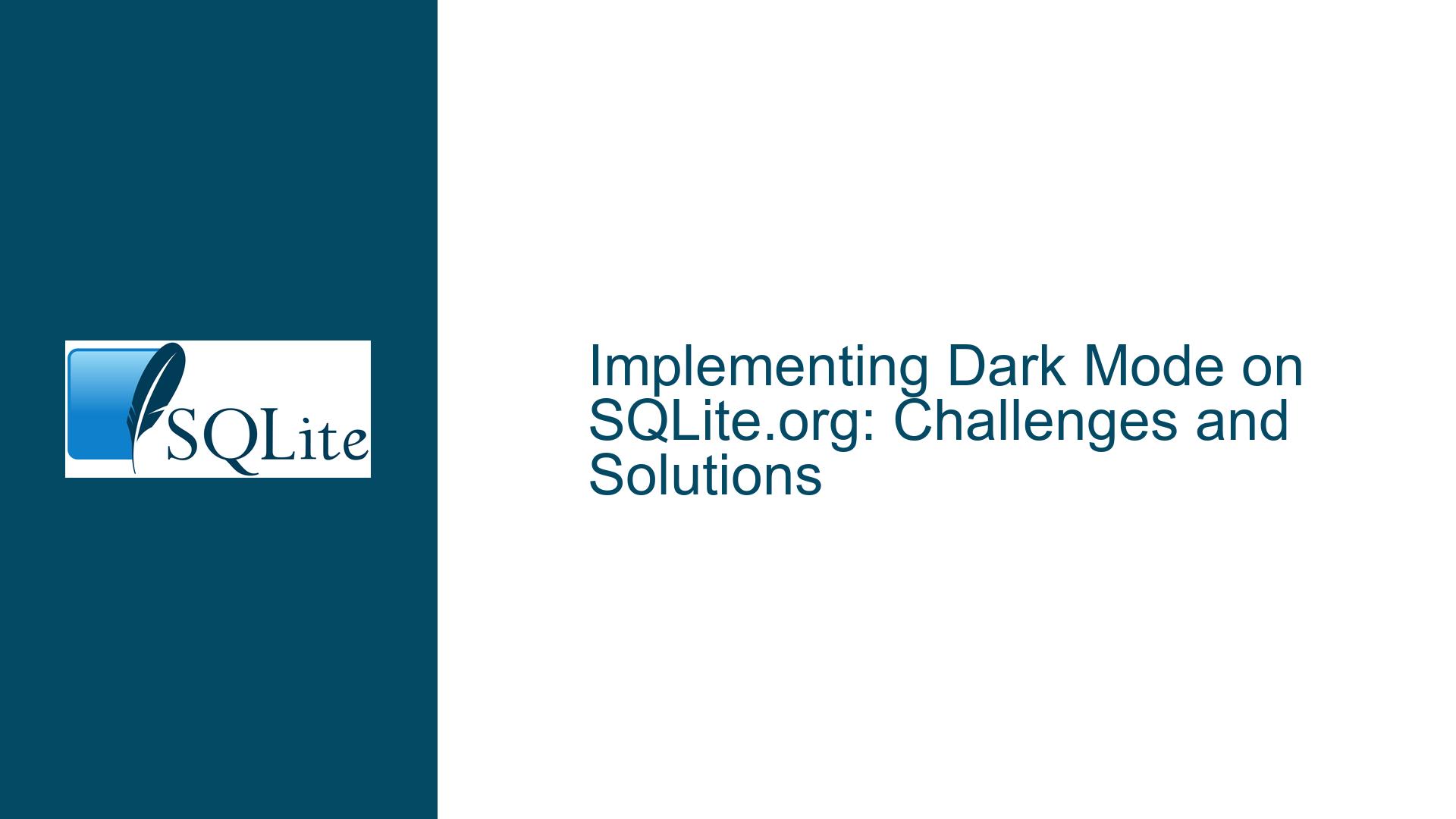Implementing Dark Mode on SQLite.org: Challenges and Solutions
The Complexity of Adding Dark Mode to SQLite.org
The request to add a dark mode to SQLite.org, while seemingly straightforward, reveals a deeper layer of complexity when considering the technical and design challenges involved. The primary issue revolves around the fact that SQLite.org is not a modern, dynamically generated website but rather a collection of hand-crafted HTML pages. This means that the site’s design and structure are deeply embedded in its HTML, making it resistant to simple CSS-based solutions like the color-scheme property. The color-scheme property, which allows a website to adopt the operating system’s default color scheme, is insufficient on its own because it does not account for the specific design elements and color contrasts that are crucial for readability and usability.
The SQLite.org website was designed with a light theme in mind, and its HTML structure reflects this design choice. The site’s color palette, font choices, and layout were all optimized for a light background, and simply inverting these colors or applying a dark filter would result in a subpar user experience. For example, text that is legible on a light background may become difficult to read on a dark background if the contrast is not properly adjusted. Additionally, images and other graphical elements may not render well in a dark theme without significant modifications.
The challenge is further compounded by the fact that SQLite.org is a static site, meaning that it does not use a content management system (CMS) or dynamic templates that could facilitate the implementation of a dark mode. Each page on the site is a standalone HTML file, and any changes to the site’s design would require manually updating each of these files. This is a time-consuming and error-prone process, especially given the size and complexity of the site.
The Limitations of CSS-Based Solutions and Browser Extensions
While CSS-based solutions like the color-scheme property and CSS filters offer a quick and easy way to implement dark mode, they are not without their limitations. The color-scheme property, for instance, only affects the default colors used by the browser for form controls, scrollbars, and other system-level elements. It does not automatically adjust the colors of text, backgrounds, or other design elements on the page. This means that while the browser’s UI may switch to a dark theme, the content of the page may remain unchanged, resulting in a disjointed and potentially unreadable experience.
CSS filters, on the other hand, can be used to invert the colors of a page or apply other color transformations. However, these filters are applied globally and do not take into account the specific design elements of the page. As a result, they can produce unintended side effects, such as inverted images or text that is difficult to read. Additionally, CSS filters can have a negative impact on performance, especially on older devices or browsers.
Browser extensions offer another potential solution for users who want to enable dark mode on SQLite.org. These extensions can apply custom CSS or JavaScript to a website, allowing users to override the site’s default styles and apply their own color scheme. However, this approach has several drawbacks. First, it requires users to install and configure a browser extension, which may not be feasible for all users. Second, browser extensions can introduce security and privacy risks, as they often have access to sensitive data and can modify the content of web pages. Finally, browser extensions are not a scalable solution, as they only affect the individual user’s experience and do not provide a consistent experience across all users.
A Comprehensive Approach to Implementing Dark Mode on SQLite.org
Given the challenges outlined above, implementing a dark mode on SQLite.org requires a comprehensive approach that goes beyond simple CSS-based solutions or browser extensions. The first step in this process is to conduct a thorough audit of the site’s design and structure. This involves identifying all the design elements that would need to be modified to support a dark theme, including text colors, background colors, images, and other graphical elements. The audit should also consider the site’s accessibility requirements, ensuring that the dark theme meets the necessary contrast ratios and other accessibility standards.
Once the audit is complete, the next step is to develop a design system that supports both light and dark themes. This design system should include a set of reusable components and styles that can be applied consistently across the site. The design system should also include guidelines for handling edge cases, such as images or other elements that may not render well in a dark theme. This approach ensures that the dark theme is not only visually appealing but also functional and accessible.
The implementation of the dark theme should be done in a way that minimizes the impact on the site’s performance and maintainability. This may involve using modern web development techniques, such as CSS variables and media queries, to dynamically switch between light and dark themes based on the user’s preferences. CSS variables, in particular, offer a powerful way to define and manage color schemes, as they allow developers to define a set of colors that can be easily switched between light and dark themes. Media queries, on the other hand, can be used to detect the user’s preferred color scheme and apply the appropriate theme automatically.
In addition to the technical implementation, it is also important to consider the user experience when implementing a dark theme. This includes providing users with an easy way to switch between light and dark themes, as well as ensuring that the transition between themes is smooth and seamless. One approach is to add a theme toggle button to the site’s navigation menu, allowing users to switch between light and dark themes with a single click. Another approach is to use the prefers-color-scheme media query to automatically apply the user’s preferred theme based on their operating system settings.
Finally, it is important to test the dark theme thoroughly before deploying it to the live site. This includes testing the theme on different devices, browsers, and operating systems to ensure that it works correctly in all scenarios. It also includes testing the theme with real users to gather feedback and identify any issues that may have been overlooked during the development process. User testing can be particularly valuable for identifying accessibility issues, as users with different visual impairments may have different needs and preferences when it comes to color schemes.
In conclusion, while adding a dark mode to SQLite.org is a challenging task, it is not insurmountable. By taking a comprehensive approach that includes a thorough design audit, the development of a robust design system, and careful consideration of the user experience, it is possible to implement a dark theme that enhances the site’s usability and accessibility. While the effort required may be significant, the benefits of providing a dark theme, particularly for users who prefer or require it, make it a worthwhile endeavor.






